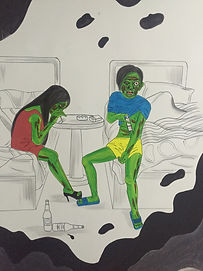
Cognitive psychology
Initial interest on addiction
August, 2012
Why am I interested in the area——A short story:
When I was undergraduate student, I took internship in the addiction treatment center, and performed several interview with policemen and clients. What impressed me most is a girl of my age.
She was a charming girl. And she used to hate go to school and worked in her uncle's factory. She did well in the factory. However, she met some friends in the leisure time. Those friends usually liked to bring her to clubs and told her that some colorful drugs could function as losing weight. She tasted a little and thus stayed awake for almost three days at the first time. In a short time, there is no doubt that she lost weight a large extent. The surprising function of losing weight and friends all around with addiction resulted in her absorbing it again and again. Finally, she was addicted to such drugs. Her parents found the truth and forced her to stay at home to avoid it. But the strong craving for drugs made her escape home and get some drugs absorbed in her old friend's home. She was just captured by police in that time.
I became interested in these addiction group:
-
Why do they choose drugs even if the weakness is extremely obvious?
-
What kind of psychological characteristic do they have?
-
What kind of experience do they have?

A picture on the wall of center
Stroop effect

My first research project:
Internet addiction disorders show conflicts on Stroop effect: Evidence from behavior and Event Related Potential (ERP)
May 2013- May 2014
Skill
Questionnaire survey, Visual Basic language, Statistical Product and Service Solutions(SPSS), Cognitive psychology, Team collaboration and organization,Critical thinking, Cognitive psychology
Partner: Peijun Yang, Xiao Yang
Goal
-
How Internet addiction disorder (IAD) impairs executive control ability.
-
Whether any abnormal results present between behavior and physical index.
Design
Executive control ability: Stroop effect (see Fig.2).
Physical index: ERP
Two groups include IAD participants and control group. Both groups need to finish Stroop task. The experimental trials were controlled by E-prime software and a 64-channel Electrical Geodesics system is used to record the physical conditions of participants.
Results
-
IAD participants showed shorter reaction time than the control group. It indicated that the IAD group had stronger executive control ability of compared with the control group.
-
However, the evidence from physical index implied that ability of IAD group was weaker than that of the control group.
Conclusion
IAD may benefit from their computer game experience, for using more frequent mouse clicks on computer. In the long run, their click speed and reaction time are better than normal people. But executive control abilities of IAD are actually worse than that of the control group on the cognitive neurological level.
My contribution
-
I was a team leader and I took part in the whole process. The whole project involved so many different abilities that it was a challenge to myself.
-
During the experiment design, I learned some Visual Basic language to revise the program in the E-prime to connect them more properly.
-
I understood how to argue my results if it exist some questions. This process also helped me to keep critical thinking.
-
I learned how to organize people based on scholar task based on different team member's characteristic.

Attention bias in addiction
October 2015 - Now
Skill
Cognitive psychology, Eye tracking, Questionnaire survey, Addiction theories
Goal
Using eye movements to measure more intuitive and sensitive attention bias of addictions.
Design
-
Visual probe task to explore attention bias of addictions.
-
Explore the inherent motivation of heroin addiction groups by using the Stimulus Response Compatibility (SRC)
Due to doing this project, more details could not be revealed without my advisors' permission. Please contact me if you are interested in it :)
My contribution
After reviewing a number of literatures, I found some reasons why teenagers are addicted to drugs repeatedly due to friends. In the model (see Fig.3), it emphasizes that only teens can be influenced by social environment, because a social context can trigger appetitive motivation (Wiers et al., 2007). Such process helped us to see the psychological mechanism behind the emerging themes and potential directions to solve the problem.
Reference:
Wiers, R. W., Bartholow, B. D., van den Wildenberg, E., Thush, C., Engels, R. C., Sher, K. J., ... & Stacy, A. W. (2007). Automatic and controlled processes and the development of addictive behaviors in adolescents: a review and a model. Pharmacology Biochemistry and Behavior, 86(2), 263-283.
Fig.3 the frame of addiction theory(Wiers et al., 2007)
